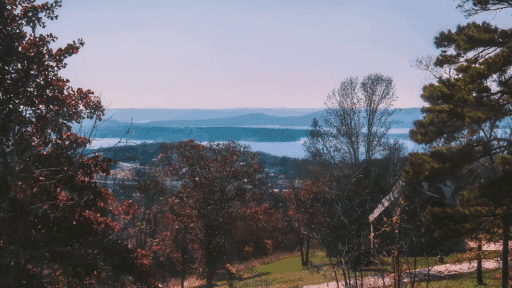Missouri is native to so many trees that you begin to wonder how this is possible. However, it is no coincidence that this area has that many native trees. Residents in the area get to enjoy a wide variety of trees and can have them around their properties for a distinct look.
One of the key reasons for this large collection is the varied land found in the area that features up to 112 regions with swamps, prairies, and hills pretty common.
Sitting on the biome crossroads where 4 ecosystems meet also makes the Missouri area a magnet for diverse trees since trees native to particular ecosystems can easily overlap. With lots of rainfall and a rich soil further boosting the potential of the area.
With well over a hundred native species, Missouri can lay claim to being the state with one of the most diverse native tree varieties in the US. However, this can easily become a challenge for residents looking for trees to grow on their properties.
This is why a guide like this highlighting only the most common native trees in Missouri is vital. The idea is to simplify your search for your next addition by providing you with not only the name but also the properties of these trees.
After this, making a decision on which tree to add to your home in Missouri becomes an easier decision. Ready to see our list?
Eastern Redbud
Starting this list is the Eastern Redbud which is native to Missouri and much of eastern U.S.. If you’re wandering through Missouri’s woodlands in early spring, one of the first signs of the season bursting forth is the Eastern Redbud, with its clusters of vibrant pink to purple flowers that seem to paint the branches before any leaves appear.
This tree is scientifically known as Cercis canadensis and typically grows as a small to medium-sized deciduous species. The Eastern Redbud can reach heights of 20 to 30 feet with a similar spread, often developing multiple trunks that give it a shrubby, rounded crown.
It thrives in open woodlands, along stream banks, limestone glades, and woodland edges where the soil is well-drained but moist, and it can handle partial shade to full sun.
Eastern Redbud is adaptable with its drought tolerant structure helping it to quickly establish and grow in a wide range of soil types. Whether your area is rocky or sandy, this plant will find a way.
Beyond its ornamental appeal, the flowers are actually edible, with a slightly sweet, pea-like flavor that Native Americans used in salads or as a garnish, and the young pods can be eaten raw or cooked.
American Sycamore
The American Sycamore is hard to miss with its massive trunk and distinctive peeling bark that reveals a patchwork of white, green, and brown underneath, almost like camouflage. It’s beautiful looking at all the colors.
Known scientifically as platanus occidentalis, this tree can grow over 100 feet in height, with a broad, irregular crown and crooked branches that spread out widely, often exceeding 80 feet across in mature specimens.
This tree’s popularity in Missouri comes from its tolerance for wet soils and periodic flooding, making it quite helpful in stabilizing riverbanks and preventing erosion.
Even though it is lightweight, this tree still features strong wood that has been used for everything from butcher blocks to musical instruments, and today it’s valued in pulp for paper production.
The American Sycamore is also home to birds like eagles and herons who often nest in its high branches, with its seed balls providing food for finches in winter.
White Oak
As the official state tree, it is not a surprise the White Oak makes this list. It is a cornerstone species that supports an incredible array of wildlife and has been integral to human use for generations.
White Oak is scientifically Quercus alba and grows into a majestic, long-lived tree, often reaching 80 to 100 feet tall with a broad, rounded crown and a straight trunk that can measure up to 4 feet in diameter.
It’s so common that you’ll find it widespread across the state, from dry upland slopes and ridges to well balanced sites. White Oak also prefers well-drained, acidic soils but adapts well to the varied terrain in Missouri.
It gets even better having the White Oak around as its acorns are a vital food source for deer, turkeys, squirrels, and over 200 insect species. The dense wood is prized for furniture, flooring, and whiskey barrels due to its watertight qualities.
One of the standout features about the White Oak tree is its lifespan. This plant can live over 300 years. For homeowners, it’s a great shade tree, but gives it space to grow and mulch around the base to retain moisture during establishment.
Flowering Dogwood
Flowing Dogwood or Cornus florida is a small deciduous tree or large shrub, usually maturing at 20 to 30 feet tall with a low-branching, spreading habit that forms a flat-topped crown. It prefers shaded, well-drained sites in upland forests, along slopes, and ravines, where acidic, organic-rich soil helps it avoid stress from heat or drought.
It only needs its seeds to be dispersed by birds to reproduce, thriving as an understory plant in mature forests.
People have long appreciated it for ornamental planting, and historically, its hard wood was used for tools like shuttles in textile mills.
If you’re adding Flowering Dogwood to your landscape, protect it from full sun to prevent its leaves from scorching. Also watch out for dogwood anthracnose, a fungal disease that’s more common in wet years.
Sweetgum
Missouri’s southeastern lowlands and along its stream bottoms is this popular tree that stands out with its star-shaped leaves and spiky seed balls. Sweetgum is also known as liquidambar styraciflua and is a medium to large tree with the capacity to grow up to 80 feet tall.
Even though Sweetgum is native to the Bootheel region, it can be found scattered northward in moist, fertile soils of floodplains and swamps.
If you’re interested in a stylish tree that can improve the aesthetics in your home, you’ll like the glossy, five-lobed leaves that turn a spectacular mix of yellow, orange, purple, and red in fall.
While the resinous gum from its wounds has been used historically as medicine for sore throats, wildlife relies on the seeds for food. The wood is commercially important for veneer and furniture.
Final Thoughts
The varied ecosystem in Missouri makes growing plants here extremely easy with the area being home to over a hundred native trees. This means your property doesn’t have to be bare with a host of different tree options to grow around it.
With options like Sweetgum and Eastern Redbud among the most popular native tree species in Missouri. Varieties are great but can easily become a challenge as residents struggle to make a decision or properly understand the properties of any one tree.
Just planting a tree is not enough, proper care is vital to keep them in a good state and avoid dangerous accidents that can cause damage. Homes with trees in Missouri rely on the help from tree service companies in taking care of their plants.
The right tree service can also provide consultation on the best one to grow depending on your terrain while also helping with maintenance and care. And when it comes to the Missouri area, Trufast Tree Service stands out.
Trufast offers a holistic tree service in the Missouri area covering everything from trimming to emergency tree removal. No matter the species or the terrain.








![20 front yard succulent garden ideas[P]](https://cdn.enthrallinggumption.com/wp-content/uploads/2023/12/20frontyardsucculentgardenideas-512x288.jpg)